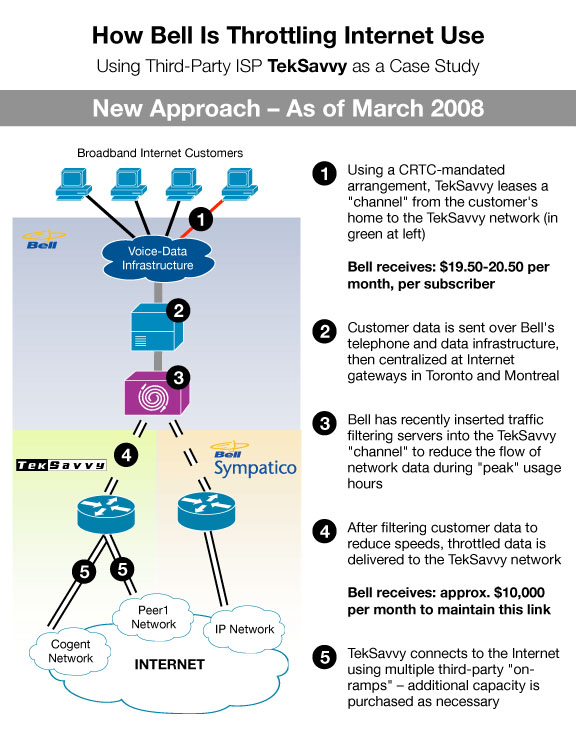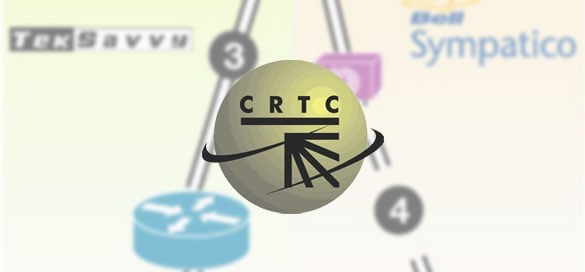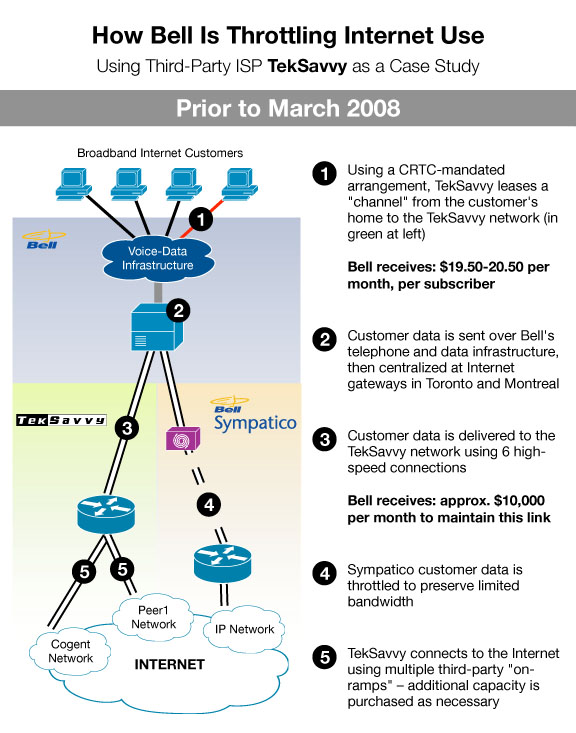Usage based billing debates are wrong… and here’s why
[Ed Note: this article was updated with new information]
The Canadian government has once again promised to overturn a CRTC decision if the CRTC doesn’t do so itself. This time around, it’s the the contentious Usage Based Billing ruling that would have crippled 3rd party ISPs from differentiating themselves in the marketplace. It’s rare for the government to step into CRTC affairs, but with the UBB issue growing in public awareness and a deadline looming less than a month away, they’ve pulled out the big guns. After all, it was only a couple of days ago that Industry Minister Tony Clement said that the feds were going to “look at the issue”. Then on Wednesday night he announced on Twitter…
True. CRTC must go back to drawing board RT @RosieBarton is it true you will overturn internet decision if crtc does not back down? [from twitter]
The CRTC certainly deserves a lion’s share of the blame, but let’s not forget that this scenario would never have arisen if it weren’t for Bell petitioning the CRTC in the first place. Even so, the UBB ruling may never have come to pass if the CRTC actually looked at the issue from a more technical point of view, as opposed to Bell’s insatiable desire for control over the lines, and the telcos moving of certain packet monitoring servers from one location to another.
Mysteries of the Pink Box revealed…
While the below description is admittedly somewhat simplistic, it’s a reaction to what I’ve read from the major media. In newspaper and TV coverage, there’s an implication largely accepted that all 3rd party ISPs are nothing more than resellers of Bell’s internet bandwidth. This isn’t entirely accurate, and has led to debates on whether we need foreign competition, and how much UBB is enough. Eliminating the misconceptions should steer the Canadian internet debate toward a more productive outcome.
The rationale for a metered internet has a lot to do with how ISP’s connect to the internet. If the load of a 3rd party ISP doesn’t affect Bell’s network then how can Bell justify charging based on load? It seems quite simple to me. All the rest of the stuff about consumer frustration and price per gig is a tangential. (thanks James)
While there are a number of technical models that Canadian 3rd party wholesalers follow, I want to focus on how and where TekSavvy gets their internet, and why UBB is a wrongheaded decision from the technology perspective. The first thing to get out of the way is the ‘torrent’ equation. People download torrents. Some of those are legal, some not so much. The Bell (and Rogers) myth that torrents are clogging the networks has never been true. Their own data shows that, and with the explosive growth of streaming video services, the torrent question becomes even less relevant. With that canard out of the way, let’ s continue…
TekSavvy pays Bell for access to the Central Office (CO) which gives them access to individual homes. The price TekSavvy pays for this access is approximately $20 a month, per customer line. They also pay $10,000 a month to access Bells ‘backhaul’ which allows them to bring in their own traffic providers. They do not use Bell’s internet service, instead paying companies like Peer1 to access the internet at large. TekSavvy is also required as part of the agreement to insure that they have enough equipment to manage their own traffic flow.
In the first graphic below, you’ll notice the pink box. This is key to the whole discussion surrounding UBB and throttling in the Canadian DSL market. This is the Deep Packet Inspection (or traffic shaping server) that Bell uses to monitor the traffic of Bells retail customers. Bell does this to ‘make sure’ their lines aren’t clogged (usually under the rubric of torrent users).
In May of 2008, Bell moved the location of its DPI (the pink box) to monitor not only its retail customers, but the backhaul traffic of wholesalers. Moving the DPI to also monitor 3rd party backhaul is what first gave Bell the ability to shape traffic for which the 3rd parties were paying.

The two charts above appeared at dslreports.com
in response to a request
This moving of the pink box also laid the questionably technical groundwork to hoodwink the CRTC into believing that Bell needed to charge TekSavvy et al the same usage overages that Bell was charging its retail customers. In short UBB was a neccesary evil in the face of over-saturated internet traffic, according to Bells smoke and mirror act. Let’s call that the ‘smoke’. The ‘mirrors’ is Bells tactic of suggesting that all 3rd party ISPs are nothing more than resellers of Bells internet service.
And the CRTC bought it.
Going forward, I’m not making an argument that the internet is completely free, and there are a number of factors, ranging from the technological to regulatory and monopoly standpoints. It does seem that the CRTC bought into Bells argument wholesale.
Addendum aka Data Dump:
The reader who wants to do a deep dive on the issue can take a look at some more technical places such as the dslreports.com forums to get a better idea of the infrastructure. Back in 2008, Rusell McOrmond wrote a great piece on the throttling issue which ties into the UBB issue.
I’d also highly recommend what Montreal computer consultant Jean-François Mezei has written on the subjects. He has a submitted to the public hearing on the issues. You can see both the main [PDF link] and rebuttal [PDF link] post on his CRTC page. He also takes a look at the issue of fibre, IPTV and more moving forward and raises some interesting points that are important but tangential to the main point of this article. You may also want to read [PDF link] his sexily titled “Overview of competitive internet access via Bell Canada’s ADSL infrastructure”.






[…] This post was mentioned on Twitter by Doug Groves, Alex . Alex said: RT @rgbfilter Canadian government poised to kill usage based billing, and why they should #UBB.. http://bit.ly/enyPs6 […]
Great article! That is some in-depth shit right there.
Thanks man… I felt that the fact that these ISPs don’t buy their bandwidth from Bell needed to be pointed out.. 🙂
No matter where the competition gets the internet, to get to individual customer, competitors like Teck savvy have to go thought bell’s line and equipment which obviously add’s to volume and possibly congestion, albeit congestion can be handled by adding more equipment at cost.
So mabe the real issue here is how much the CRTC has allowed bell to charge competitors for access to there equipment. According to the article it’s about $20 per customer line. So even if this issues is won by competitors, Bell will argue therefore that the cost per customer line will need to increase.
Thanks for replying. The “go through Bell’s line” discussion is really what clouds the whole 3rd party traffic issue. As George Burger of TekSavvy mentioned in a recent online chat that… “The CRTC itself has said that Bell more than recoups its expenses from the flat rate compnent of the services, which means, as we maintain, that the incrmental usage is close to free, and as such, as proposed, punitively priced.”
Here’s a transcript of the chat…
http://www.theglobeandmail.com/news/technology/tech-news/ubb-internet/small-isp-reacts-to-crtc-reversal/article1894318/
In short, TekSavvy and other ISPs are required to provide the hardware infrastructure capable of supporting connections between customer homes and the Central Office. This means that there is no impact on Bell residential customers. The only possible point of congestion is the backhaul if the pipes weren’t fat enough, but even Bell’s own numbers show that this really isn’t an issue. This is something we covered in a previous article, which is linked out in the one above.
[…] even if many of the talking points about 3rd parties using ‘Bell’s networks’ just a little inaccurate. Share and Enjoy: These icons link to social bookmarking sites where readers can […]
[…] currently footing the bill for “heavy” users. But considering what’s already known about Internet technology, we already know there is no such thing. var addthis_config = {"data_track_clickback":true}; […]
207251 358263Thanks for the post, was an fascinating read. Curious as to how you came about that solution 397485